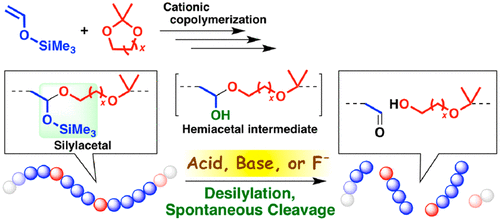当前位置:
X-MOL 学术
›
ACS Macro Lett.
›
论文详情
Our official English website, www.x-mol.net, welcomes your
feedback! (Note: you will need to create a separate account there.)
Desilylation-Triggered Degradable Silylacetal Polymers Synthesized via Controlled Cationic Copolymerization of Trimethylsilyl Vinyl Ether and Cyclic Acetals
ACS Macro Letters ( IF 5.1 ) Pub Date : 2019-10-25 , DOI: 10.1021/acsmacrolett.9b00745 Ryusei Kato 1 , Arihiro Kanazawa 1 , Sadahito Aoshima 1
ACS Macro Letters ( IF 5.1 ) Pub Date : 2019-10-25 , DOI: 10.1021/acsmacrolett.9b00745 Ryusei Kato 1 , Arihiro Kanazawa 1 , Sadahito Aoshima 1
Affiliation

|
Silylacetal was demonstrated to function as a promising cleavable moiety for preparing polymers degradable via desilylation under diverse, mild conditions. The silylacetal moieties were installed in the main chain of the polymers via the controlled cationic copolymerization of trimethylsilyl vinyl ether (TMSVE) and a cyclic acetal under appropriately designed conditions. Importantly, desilylation reactions of the silylacetal units occurred under weak acid, base, or fluoride ion conditions, which triggered the degradation of the polymer via the spontaneous cleavage of the unstable hemiacetal moieties generated by the desilylation. Moreover, silylacetal moieties were successfully incorporated at the desired positions in the main chain via the addition of a small portion of TMSVE during the controlled cationic copolymerization of a vinyl ether and cyclic acetal. The strategy devised in this study will allow the design of elaborate polymers that undergo degradation triggered by various stimuli.
中文翻译:

三甲基甲硅烷基乙烯基醚和环状缩醛的可控阳离子共聚合成脱甲硅烷基化引发的可降解甲硅烷基缩醛聚合物
甲硅烷基缩醛被证明可作为一种有前途的可裂解部分,用于制备可在多种温和条件下通过脱甲硅烷化降解的聚合物。在适当设计的条件下,通过三甲基甲硅烷基乙烯基醚 (TMSVE) 和环状缩醛的受控阳离子共聚,将甲硅烷基缩醛部分安装在聚合物的主链中。重要的是,甲硅烷基缩醛单元的脱甲硅烷基化反应在弱酸、碱或氟离子条件下发生,这通过脱甲硅烷化产生的不稳定半缩醛部分的自发裂解引发了聚合物的降解。而且,在乙烯基醚和环状缩醛的受控阳离子共聚过程中,通过添加一小部分 TMSVE 成功地将甲硅烷基缩醛部分掺入到主链中的所需位置。本研究中设计的策略将允许设计经受各种刺激触发的降解的精细聚合物。
更新日期:2019-10-25
中文翻译:

三甲基甲硅烷基乙烯基醚和环状缩醛的可控阳离子共聚合成脱甲硅烷基化引发的可降解甲硅烷基缩醛聚合物
甲硅烷基缩醛被证明可作为一种有前途的可裂解部分,用于制备可在多种温和条件下通过脱甲硅烷化降解的聚合物。在适当设计的条件下,通过三甲基甲硅烷基乙烯基醚 (TMSVE) 和环状缩醛的受控阳离子共聚,将甲硅烷基缩醛部分安装在聚合物的主链中。重要的是,甲硅烷基缩醛单元的脱甲硅烷基化反应在弱酸、碱或氟离子条件下发生,这通过脱甲硅烷化产生的不稳定半缩醛部分的自发裂解引发了聚合物的降解。而且,在乙烯基醚和环状缩醛的受控阳离子共聚过程中,通过添加一小部分 TMSVE 成功地将甲硅烷基缩醛部分掺入到主链中的所需位置。本研究中设计的策略将允许设计经受各种刺激触发的降解的精细聚合物。











































 京公网安备 11010802027423号
京公网安备 11010802027423号